List of maritime disasters in the 18th century
.jpg)
A maritime disaster is an event which usually involves a ship or ships and can involve military action. Because of the nature of maritime travel, there is often a substantial loss of life. This list covers those disasters where 30 or more lives were lost.
- This transport-related list is incomplete; you can help by expanding it.
Peacetime disasters
Many maritime disasters happen outside the realms of war. All ships, including those of the military, are vulnerable to problems from weather conditions, faulty design or human error. Some of the disasters below occurred in periods of conflict, although their losses were unrelated to any military action. The table listings are in descending order of the magnitude of casualties suffered.
| Year | Country | Description | Deaths | Image |
|---|---|---|---|---|
| 1703 | |
The Channel Storm – In November 1703 a great storm swept the English Channel, causing the loss of thirteen men-of-war and the deaths of an estimated 1500 seamen. | 1,500+ | |
| 1707 | The Scilly naval disaster of 1707 – On 22 October 1707, a Royal Navy fleet en route from Gibraltar to Portsmouth sailed through dangerous reefs west of the Isles of Scilly. Four ships (HMS Association, HMS Eagle, HMS Romney and HMS Firebrand) sank. The exact number of crew lost is unknown. Statements vary between 1,400[1] and over 2,000.[2] It was later determined that the main cause was the navigators' inability to calculate their longitude accurately. | 1,400-2,000 | .jpg) | |
| 1744 | HMS Victory – The 100-gun first-rate sank in a storm in the English Channel while returning to England on the night of 4 October 1744. With her were lost Admiral Sir John Balchen and her entire complement of around 1,150 men. | 1,150 |  | |
| 1760 | HMS Ramillies – the second-rate, formerly HMS Royal Katherine, was wrecked at Bolt Head near Plymouth on 15 February 1760. Of the crew of 850 aboard, 20 seamen and one midshipman survived. | 829 |  | |
| 1782 | HMS Royal George – sank while moored at Portsmouth while the ship was being heeled for repairs on the underside on 29 August 1782 with a full crew and a considerable number of visitors aboard. The ship heeled too far and began taking water in the gun ports and sank. More than 800 people were lost, including Rear Admiral Richard Kempenfelt, and up to 300 women and 60 children who were visiting the ship. | 800 | .jpg) | |
| 1800 | HMS Queen Charlotte – a British 100-gun first-rate ship of the line that, on 17 March 1800, whilst serving as flagship of Vice-Admiral Lord Keith, was reconnoitering the Balearic island of Cabrera when she caught fire. She exploded and sank, killing 673 officers and men. | 673 | 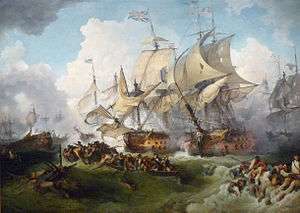 | |
| 1738 | Leusden – On 1 January 1738 the slave ship "Leusden" ran aground on a sand bank in the Marowijne River in Suriname. An estimated 664 people were lost when, as the ship sank, the crew sealed the compartments, locking in the slaves who had been herded within. | 664 | ||
| 1782 | HMS Glorieux – On 16–17 September 1782 the second-rate was lost with all hands in a hurricane off the coast of Newfoundland. | 600 | ||
| 1749 | HMS Namur – the second-rate was wrecked on 14 April 1749 in a storm near Fort St David. In total, 520 of her crew were drowned, though Captain Marshal survived. | 520 | 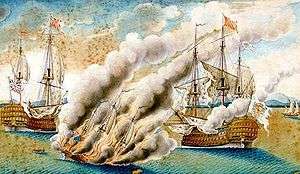 | |
| 1794 | HMS Ardent – In April 1794 the third-rate was stationed off the harbour of Villa Franca, Corsica to watch two French frigates. It is presumed that she caught fire and blew up. HMS Berwick encountered some wreckage while cruising in the Gulf of Genoa in the summer that suggested fire and an explosion. A part of Ardent's quarter deck with some gunlocks deeply embedded in it was found floating in the area as was splinter netting driven into planking. No trace was ever found of her 500 crew. | 500 | ||
| 1781 | Prinses Sophia Albertina – Sank off Texel in the Netherlands in heavy weather. 419 people died. | 419 | ||
| 1782 | HMS Centaur – In September 1782 the third-rate ship of the line was one of the ships escorting prizes back to Britain from Jamaica when she foundered in the 1782 Central Atlantic hurricane near the Newfoundland Banks. Some 400 of her crew were lost. Captain John Nicholson Inglefield and 11 of his crew survived the wreck in one of her pinnaces, reaching the Azores after being in the open boat for 16 days without compass, quadrant or sail, and with only two quart bottles of water. | 400 | 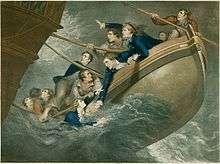 | |
| 1703 | HMS Restoration – The third-rate was wrecked on the Goodwin Sands in the Great Storm of 1703 on 27 November 1703. All 387 men were lost in the sinking. | 387 | ||
| 1800 | USS Insurgent – On 29 April 1800 the frigate was ordered to cruise between the West Indies and the US coast to protect US shipping interests and to capture any enemy vessels encountered. Insurgent departed Baltimore 22 July and after a brief stop at Hampton Roads sailed for her station 8 August 1800. Never heard from again, the frigate and her crew were presumed lost as a result of the severe storm which struck the West Indies 20 September 1800. | 340 |  | |
| 1796 | HMS Amphion – On 22 September 1796 the fifth-rate ship of the line was completing repairs at Plymouth, England. Being due to sail the next day, she had more than 100 relatives and visitors aboard as well as her crew. At about 4 p.m. she exploded without warning killing 300 of the 312 aboard. The cause was never proven, but it was thought that the ship's gunner accidentally spilled gunpowder near the fore magazine which then ignited and set off the magazine itself. | 300 | ||
| 1743 | Hollandia – was a Dutch East India Company ship that was wrecked near Scilly on 13 July 1743 causing 276 deaths. She became separated from the fleet she was traveling with and struck Gunner Rock near Annet, Isles of Scilly in the early hours of the morning sinking nearby with the loss of all hands. | 276 | ||
| 1799 | HMS Lutine – Sank off Vlieland in heavy weather. She was carrying a large cargo of gold, most which remains unsalvaged. 269 people were lost. | 269 |  | |
| 1735 | Vliegend Hert – Dutch East India Company ship sank due to heavy weather. 256 people died. | 256 | ||
| 1755 | Doddington – On 17 July 1755 the Honourable East India Company ship was wrecked at Bird Island in Algoa Bay near present-day Port Elizabeth after she struck a rock. Of 270 crew and passengers, 23 survived. | 247 |  | |
| 1781 | Negotie – Dutch East India Company ship Negotie sank off Texel due to heavy weather. 238 people died. | 238 | ||
| 1797 | HMS Tribune – On 16 November 1797 the fifth-rate was wrecked and sank after running onto Thrum shoal at Herring Cove, Nova Scotia in a storm. 12 of the 244 aboard survived. | 232 |  | |
| 1702 | HMS Northumberland – was a 70-gun third-rate ship of the line of the English Royal Navy that was lost on 27 November 1703 with all hands at the Goodwin Sands in the Great Storm of 1703. Captain Greenway was among the 220 men (including 24 marines) who drowned. | 220 | ||
| 1703 | HMS Stirling Castle – The third-rate was wrecked on the Goodwin Sands off Deal on 27 November 1703, killing 206 men. The same storm also wrecked HMS Northumberland and HMS Restoration with large losses. | 206 | ||
| 1726 | Aagtekerke – a Dutch East India Company ship that was lost without trace in 1726. The ship was lost after leaving Cape Town which it left on 3 January 1726 and Batavia. There is some evidence from the crew of the wrecked ship Zeewyk that Aagtekerke may have been wrecked on the Abrolhos Islands because they found some remains of a Dutch vessel that had been wrecked before them. | 200 | ||
| 1786 | Halsewell – On 6 January 1786 the Honourable East India Company ship was wrecked at the start of a voyage from London to Madras. She lost her masts in a fierce storm in the English Channel and was driven onto the rocks below a cliff on the Isle of Purbeck in Dorset, England. Of her 240 crew and passengers, 74 survived. | 166 |  | |
| 1717 | Whydah Gally – a slave ship that was captured by the pirate Captain "Black Sam" Bellamy, and refitted as his flagship. On 26 April 1717 off of Cape Cod she ran aground and capsized in a fierce storm. Bellamy and 143 of his crew were lost, as was and more than 4.5 short tons (4.1 tonnes) of gold and silver. There were two survivors. Whydah and her treasure eluded discovery for over 260 years, until being discovered in 1984 under only 14 feet (4.3 m) of water and 5 feet (1.5 m) of sand. She is the only authenticated pirate shipwreck yet found.[3] | 144 | 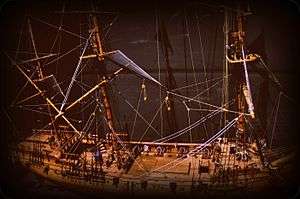 | |
| 1780 | HMS Ontario – she sank in a storm on 31 October 1780 while en route from Fort Niagara to Oswego. About 130 men died with the ship,[4] comprising 60 British soldiers of the 34th (Cumberland) Regiment of Foot, a crew of about 40 Canadians and possibly up to 30 American prisoners of war. News of the ship's sinking was kept quiet for a number of years to hide the military loss.[5] | 130–172 | ||
| 1777 | USS Reprisal - On September 14, 1777, Reprisal left France, for the United States. About October 1, Reprisal was lost off the banks of Newfoundland and all 129 on board, except the cook, went down with her. | 129 | ||
| 1799 | HMS Orestes – The 18-gun Dutch-built brig-sloop disappeared around 5 November 1799 in the Indian Ocean and is presumed to have foundered in a hurricane with the loss of her entire crew. | 125 | ||
| 1797 | HMS Vipere – A British brig-sloop, previously captured from the French, capsized in the Shannon Estuary just off the coast of County Clare.[6] | 120 | ||
| 1761 | Auguste – On 15 November 1761 the sailing ship Auguste sank after grounding in a gale at Aspy Bay, Cape Breton, Nova Scotia in 1761 while carrying exiles from the fall of New France. Of the 121 aboard, seven survived. | 114 | ||
| 1793 | Pelican – On 20 March 1793 the privateer, while on a pleasure and working-up cruise, sank in a sudden storm on the River Mersey. Of 134 people aboard, 102 were lost. | 102 | ||
| 1800 | USS Pickering - Ordered to join Commodore Thomas Truxton's squadron on the Guadeloupe Station in the West Indies, she sailed from Newcastle, Delaware on 20 August, and was never heard from again. She is presumed to have been lost with all hands in a gale in September, but this was never proven. This storm is also thought to have sunk the USS Insurgent, which vanished without a trace. The exact cause of the cutter's disappearance remains a mystery. | 90 |  | |
| 1781 | USS Saratoga - On 18 March 1781 the sloop USS Saratoga was lost with all hands during a gale off the Bahamas. | 86 |
Wartime disasters
Disasters with high losses of life can occur in times of armed conflict. Shown below are some of the known events with major losses.
| Year | Country | Description | Lives lost | Image |
|---|---|---|---|---|
| 1741 | Battle of Cartagena de Indias – from March to May 1741 the Spanish Admiral Blas de Lezo defended the city against the British attack led by Admiral Edward Vernon. British forces suffered heavy losses, estimated between 9,500–11,500 men, plus six Royal Navy ships lost, 17 ships of the line heavily damaged, four frigates and 27 transports lost. | 9,500-11,500 | 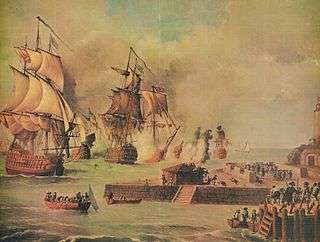 | |
| 1795 | Séduisant – a French 74-gun ship of the line that sank on 16 December 1796 while leaving Brest for the Expédition d'Irlande. Out of 600 crew and 610 soldiers, 60 survived. The wreck was found in 1986. | 1,150 | ||
| 1708 | San Jose – On 8 June 1708 in an engagement between a British squadron under Charles Wager and the Spanish treasure fleet, known as Wager's Action, the Spanish ship exploded and sank killing 689 of the 700 aboard. | 689 | ||
| 1710 | Dannebroge – On 4 October 1710, in the Great Northern War, the Dano-Norwegian ship-of-the-line exploded and sank after catching fire in the Bay of Køge. Few of the 600 men survived the explosion: some sources say three; others nine. | 591-597 | ||
| 1796 | Impatiente – On 29 December 1796 the frigate sank in a gale. Seven of the 413 aboard survived. | 413 | ||
| 1798 | Orient – The French 118-gun Océan-class ship of the line was flagship of the French fleet at the Battle of the Nile in August 1798. She came under fire from five British ships, caught fire and exploded when her magazines detonated. The number of casualties has been disputed with the British reporting 70 survivors. Her crew was far from complete at the time, and a number of survivors may have been rescued by French ships. Contre-amiral Denis Decrès reported 760 survivors. | 370-1060 | 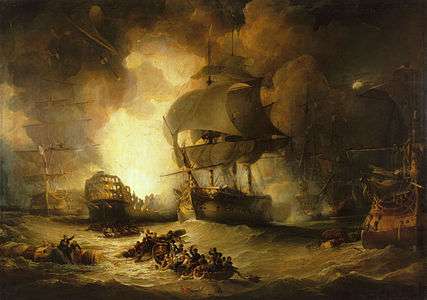 | |
| 1758 | Duke William – The British transport, bound from Canada to France, was caught by a storm off England. She sank on 13 December 1758, killing 366 Acadian prisoners. | 366 | ||
| 1799 | HMS Sceptre – a third-rate ship of the line caught at anchor in a storm on 5 November 1799 with seven other ships in Table Bay near the Cape of Good Hope. About 1900 hrs she was driven ashore on a reef at Woodstock Beach. She was battered to pieces and about 349 sailors and marines were lost. One officer, two midshipmen, 47 sailors and one marine were saved but nine of these died on the beach. | 358 |  | |
| 1794 | Vengeur du Peuple – In the battle named the Glorious First of June on 1 June 1794 the ship of the line was disabled after a fierce duel with HMS Brunswick and surrendered after losing hope of rescue by a French ship. After a few hours, as British ships were beginning rescue operations she listed and foundered taking almost half her crew with her. Of the 723 aboard 356 were lost in the battle and sinking. | 356 |  | |
| 1778 | USS Randolph – On 7 March 1778 the US frigate's lookouts sighted sail on the horizon which proved to be the British 64-gun third-rate ship of the line HMS Yarmouth. That evening Randolph engaged the British warship and shot away 2 of Yarmouth's masts when some unknown cause, possibly a chance spark or more likely a cannonball hitting her magazine, ignited her magazine and Randolph exploded. 311 of her crew were lost; four survived. | 311 |  | |
| 1795 | Alcide – In the Battle of Hyères Islands on 13 July 1795 the 74-gun ship of the line was becalmed and had to fight the British ships HMS Victory, Culloden and Cumberland. She damaged Culloden's rigging and almost dismasted Victory but was outgunned and surrendered to Cumberland. The French frigates Justice and Alceste tried to tow her to safety but Victory drove them off. Soon after a fire broke out on Alcide', reportedly in her tops or from her own heated shots, and she exploded 30 minutes later killing 300 men. The British squadron rescued 300 survivors. | 300 | ||
| 1797 | Droits de l'Homme – In the Action of 13 January 1797, off Penmarch, the French 74-gun ship of the line met the British frigates HMS Indefatigable and Amazon. The sea was rough preventing Droits de l'Homme from using her lower deck batteries and from boarding the British frigates. After 13 hours of combat the French ship, having lost her rudder, masts and anchors, ran aground off Plozévet. A store delayed rescue for five days and 250–300 of her crew were lost. | 250-390 | 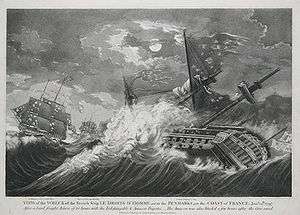 | |
See also
- List of maritime disasters
- List of maritime disasters in the 19th century
- List of maritime disasters in the 20th century
- List of maritime disasters in World War I
- List of maritime disasters in World War II
- List of maritime disasters in the 21st century
- Shipwreck
- List of shipwrecks
- List of disasters
- List of accidents and disasters by death toll
- List by death toll of ships sunk by submarines
- List of RORO vessel accidents
References
- ↑ biography of Cloudesley Shovell. Retrieved 8 January 2010.
- ↑ Sir Clowdisley Shovell and The Association, by Peter Mitchell, on 4 July 2007
- ↑ Commonwealth of Massachusetts v. Maritime Underwater Surveys, Inc., 403 Mass. 501 (Massachusetts Supreme Court 1988).
- ↑ Some sources say 172, Wood, William (1915). Chronicles of Canada: Part IX National Highways All Afloat – A Chronicle of Craft and Waterways. Toronto: Glasgow, Brook & Company.
- ↑ "HMS Ontario (Post-Revoluntary War Great Lakes British Brig-Sloop of War)". Doran Bay Ships. Retrieved 15 June 2008. External link in
|publisher=(help) - ↑ "La Vipere Record". Irishshipwrecks.com. Retrieved 10 February 2013.